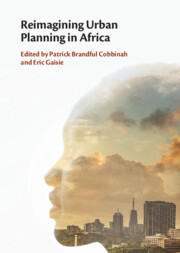Book contents
- Reimagining Urban Planning in Africa
- Reimagining Urban Planning in Africa
- Copyright page
- Contents
- Contributors
- Foreword
- Preface
- Acknowledgements
- Abbreviations
- Part I Understanding Sustainable Urban Planning in Africa
- Part II Case Studies on Urban Planning in African Countries
- Part III Sustainable Urban Planning in Africa
- 14 On the Need for Sustainable Digital Urban Infrastructure in Twenty-First-Century South African Cities
- 15 The South African Landownership Struggle
- 16 The 2030 Agenda, Climate Urbanism and Urban Planning in Zimbabwe
- 17 Urban Planning and Quality of Life of Urban Residents in Africa
- 18 Realising Rights in Complex Informal Settlements Contexts
- 19 Participatory Design Won’t Fix Unequal Southern African Cities
- 20 Enabling Smart Mobility in African Cities
- 21 On the Future of Urban Planning in Africa
- Index
- References
15 - The South African Landownership Struggle
A Thematic Commentary
from Part III - Sustainable Urban Planning in Africa
Published online by Cambridge University Press: 07 December 2023
- Reimagining Urban Planning in Africa
- Reimagining Urban Planning in Africa
- Copyright page
- Contents
- Contributors
- Foreword
- Preface
- Acknowledgements
- Abbreviations
- Part I Understanding Sustainable Urban Planning in Africa
- Part II Case Studies on Urban Planning in African Countries
- Part III Sustainable Urban Planning in Africa
- 14 On the Need for Sustainable Digital Urban Infrastructure in Twenty-First-Century South African Cities
- 15 The South African Landownership Struggle
- 16 The 2030 Agenda, Climate Urbanism and Urban Planning in Zimbabwe
- 17 Urban Planning and Quality of Life of Urban Residents in Africa
- 18 Realising Rights in Complex Informal Settlements Contexts
- 19 Participatory Design Won’t Fix Unequal Southern African Cities
- 20 Enabling Smart Mobility in African Cities
- 21 On the Future of Urban Planning in Africa
- Index
- References
Summary
The historical apartheid dichotomy and its present-day effects in South Africa remain characterised by exclusion and inequality along racial lines, with specific reference to land access. While land redistribution efforts have sought to foster inclusion and equity, the narratives on landownership remain multi-dimensional. This study aimed to determine the underlining narrative themes and potential gaps in research regarding the landownership struggle in South Africa. The methodology includes a bibliometric review to identify keywords, clusters and research trends in relevant publications through VOSviewer (v1.6.17) software. Furthermore, a thematic analysis using NVivo 12 was applied to achieve the research aim. Four clusters were identified, including agricultural production, land reform, the rural economy and poverty reduction, with recent research focused on agricultural land, livelihoods and poverty alleviation. The findings highlighted the continuing inequality in landownership and a gap in research regarding the post-redistribution use of land. The chapter proposes a reimagining of urban planning in South Africa, Africa and the global south through identifying future research avenues in land redistribution to catalyse the equitable and productive utilisation of land. This includes research on the role of financial support mechanisms and political capacity in land redistribution interventions.
- Type
- Chapter
- Information
- Reimagining Urban Planning in Africa , pp. 261 - 281Publisher: Cambridge University PressPrint publication year: 2023



